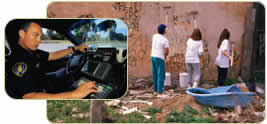

 | |||||||||||||||||||||||||||||
|
CCDO Home / Weed & Seed 
Weed and Seed, a community-based strategy sponsored by the U.S. Department of Justice (DOJ), is an innovative, comprehensive multiagency approach to law enforcement, crime prevention, and community revitalization. CCDO oversees the Weed and Seed initiative. Weed and Seed is foremost a strategy—rather than a grant program—that aims to prevent, control, and reduce violent crime, drug abuse, and gang
The strategy involves a two-pronged approach: law enforcement agencies and prosecutors cooperate in "weeding out" violent criminals and drug abusers and public agencies and community-based private organizations collaborate to "seed" much-needed human services, including prevention, intervention, treatment, and neighborhood restoration programs. A community-oriented policing component bridges the weeding and seeding elements. At each site, the relevant U.S. Attorney's Office plays a leadership role in organizing local officials, community representatives, and other key stakeholders to form a steering committee. The U.S. Attorney's Office also facilitates coordination of federal, state, and local law enforcement efforts so that sites effectively use federal law enforcement partners in weeding strategies. In some instances, the U.S. Attorney's Office helps sites mobilize resources from a variety of federal agencies for seeding programs. The Weed and Seed strategy is a multilevel strategic plan that includes four basic components: law enforcement; community policing; prevention, intervention, and treatment; and neighborhood restoration. Four fundamental principles underlie the Weed and Seed strategy: collaboration, coordination, community participation, and leveraging of resources. In most Weed and Seed sites, joint task forces of law enforcement agencies from all levels of government aim to reduce both crime and fear of crime, which gives back hope to residents living in distressed neighborhoods and sets the stage for community revitalization. Community policing embraces two key concepts—community engagement and problem solving. Community policing strategies foster a sense of responsibility within the community for solving crime problems and help develop cooperative relationships between the police and residents. The prevention, intervention, and treatment component concentrates an array of human services on the designated neighborhood and links law enforcement, social services agencies, the private sector, and the community to improve the overall quality of services to residents. Every Weed and Seed site is required to establish a Safe Haven, a multiservice center often housed in a school or community center, where many youth- and adult-oriented services are delivered. Through coordinated use of federal, state, local, and private-sector resources, neighborhood restoration strategies focus on economic development, employment opportunities for residents, and improvements to the housing stock and physical environment of the neighborhood. Communities interested in becoming Weed and Seed Communities (WSCs) must submit a Notice of Intent to the U.S. Attorney’s Office (USAO). WSCs must be developed in partnership with many local organizations to reduce crime and improve the quality of life in a community primarily through the redeployment of existing public and private resources into the community. Promoting the long-term health and resilience of the community is a true goal of Weed and Seed, so sustainability must be a key part of a site's structure. The foundation for sustainability involves maintaining the steering committee as a mechanism for ongoing implementation of the Weed and Seed strategy beyond the life of the grant and identifying and securing existing and new resources and funding sources. | |||||||||||||||||||||||||||||
